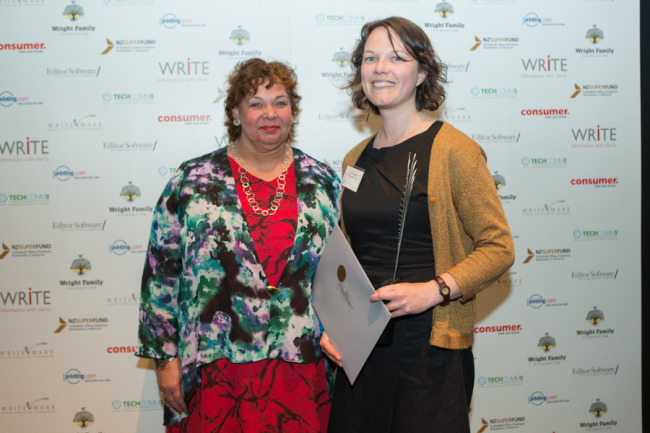Erinna Gilkison, Statistics NZ

Judge Maryland Spencer with Erinna Gilkison
Commuting patterns in greater Christchurch: Trends from the Census of Population and Dwellings 2006 and 2013
In 2006, the Cathedral Square area unit had a density of 11,784 people giving a workplace address per square kilometre, and this fell to 4,285 people giving a workplace address per square kilometre in 2013.
In 2006, the employment density for Cathedral Square was 11,784 people per square kilometre. This fell to 4,285 in 2013.
You’ve reduced this sentence from 35 words to 20. Impressive!
The structure of both your revised sentences is strong. Both use strong subjects and active verbs that capture the intended meaning. You’ve used clear, concise vocabulary and removed most jargon. You’ve created a pleasant ‘story’ flavour.
The original was just about understandable, but very complex. The technical qualifiers (‘giving a workplace address per square kilometre’) got in the way of the meaning. You’ve captured the intended meaning much more clearly in the revision. Well done.
Overall, this is an excellent revision. It’s clear, concise and appropriate for the intended audience. It moves from a reporting of statistical data to a sentence that more clearly interprets the data.
Statistics New Zealand aims to empower decision-makers by adding value to New Zealand’s most important data. Publishing information in plain English is one way we do this.
Our statistical analysts work with information that can affect all New Zealanders. The importance of this information means our publications must be readable, even if the analysts feel restricted by technical terms or lack of time to translate terms into everyday language.
Our contender for ‘best sentence transformation’ is from a series of reports about changes in commuting patterns. It’s an example of how using the correct technical terms from a survey can get in the way of a reader’s understanding. However, when editors and analysts work together we can transform complex information into writing that is both technically accurate, and understood by its target audience.
It’s great to have our efforts recognised, and to be part of an organisation that understands the value of plain language.